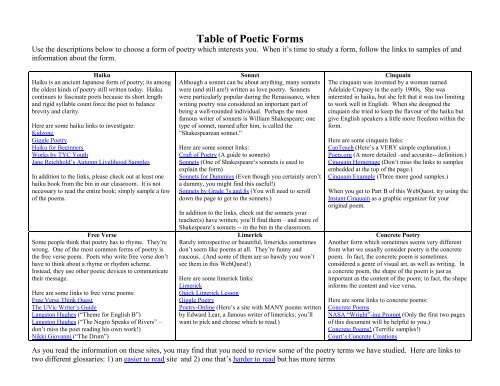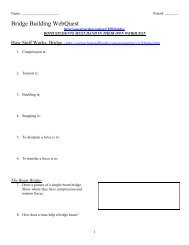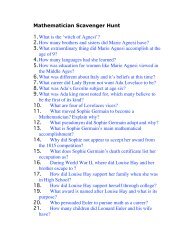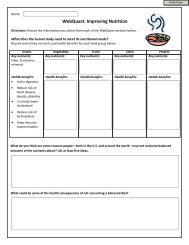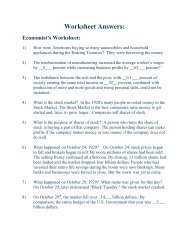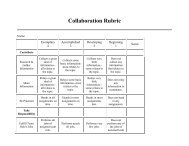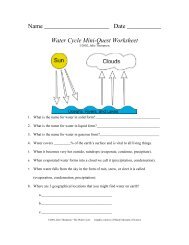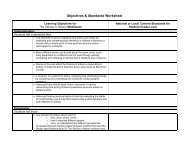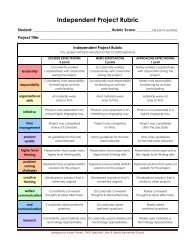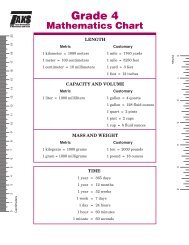Create successful ePaper yourself
Turn your PDF publications into a flip-book with our unique Google optimized e-Paper software.
<strong>Table</strong> <strong>of</strong> <strong>Poetic</strong> <strong>Forms</strong><br />
Use the descriptions below to choose a form <strong>of</strong> poetry which interests you. When it’s time to study a form, follow the links to samples <strong>of</strong> and<br />
information about the form.<br />
Haiku<br />
Haiku is an ancient Japanese form <strong>of</strong> poetry; its among<br />
the oldest kinds <strong>of</strong> poetry still written today. Haiku<br />
continues to fascinate poets because its short length<br />
and rigid syllable count force the poet to balance<br />
brevity and clarity.<br />
Here are some haiku links to investigate:<br />
Kidzone<br />
Giggle Poetry<br />
Haiku for Beginners<br />
Works by TYC Youth<br />
Jane Reichhold’s Autumn Livelihood Samples<br />
In addition to the links, please check out at least one<br />
haiku book from the bin in our classroom. It is not<br />
necessary to read the entire book; simply sample a few<br />
<strong>of</strong> the poems.<br />
Free Verse<br />
Some people think that poetry has to rhyme. They’re<br />
wrong. One <strong>of</strong> the most <strong>com</strong>mon forms <strong>of</strong> poetry is<br />
the free verse poem. Poets who write free verse don’t<br />
have to think about a rhyme or rhythm scheme.<br />
Instead, they use other poetic devices to <strong>com</strong>municate<br />
their message.<br />
Here are some links to free verse poems:<br />
Free Verse Think Quest<br />
The UVic Writer’s Guide<br />
Langston Hughes (“Theme for English B”)<br />
Langston Hughes (“The Negro Speaks <strong>of</strong> Rivers” –<br />
don’t miss the poet reading his own work!)<br />
Nikki Giovanni (“The Drum”)<br />
Sonnet<br />
Although a sonnet can be about anything, many sonnets<br />
were (and still are!) written as love poetry. Sonnets<br />
were particularly popular during the Renaissance, when<br />
writing poetry was considered an important part <strong>of</strong><br />
being a well-rounded individual. Perhaps the most<br />
famous writer <strong>of</strong> sonnets is William Shakespeare; one<br />
type <strong>of</strong> sonnet, named after him, is called the<br />
“Shakespearean sonnet.”<br />
Here are some sonnet links:<br />
Craft <strong>of</strong> Poetry (A guide to sonnets)<br />
Sonnets (One <strong>of</strong> Shakespeare’s sonnets is used to<br />
explain the form)<br />
Sonnets for Dummies (Even though you certainly aren’t<br />
a dummy, you might find this useful!)<br />
Sonnets by Grade 7s and 8s (You will need to scroll<br />
down the page to get to the sonnets.)<br />
In addition to the links, check out the sonnets your<br />
teacher(s) have written; you’ll find them – and more <strong>of</strong><br />
Shakespeare’s sonnets -- in the bin in the classroom.<br />
Limerick<br />
Rarely introspective or beautiful, limericks sometimes<br />
don’t seem like poems at all. They’re funny and<br />
raucous. (And some <strong>of</strong> them are so bawdy you won’t<br />
see them in this WebQuest!)<br />
Here are some limerick links:<br />
Limerick<br />
Quick Limerick Lesson<br />
Giggle Poetry<br />
Poetry-Online (Here’s a site with MANY poems written<br />
by Edward Lear, a famous writer <strong>of</strong> limericks; you’ll<br />
want to pick and choose which to read.)<br />
Cinquain<br />
The cinquain was invented by a woman named<br />
Adelaide Crapsey in the early 1900s. She was<br />
interested in haiku, but she felt that it was too limiting<br />
to work well in English. When she designed the<br />
cinquain she tried to keep the flavour <strong>of</strong> the haiku but<br />
give English speakers a little more freedom within the<br />
form.<br />
Here are some cinquain links:<br />
CanTeach (Here’s a VERY simple explanation.)<br />
Poets.org (A more detailed –and accurate-- definition.)<br />
Cinquain Homepage (Don’t miss the links to samples<br />
embedded at the top <strong>of</strong> the page.)<br />
Cinquain Example (Three more good samples.)<br />
When you get to Part B <strong>of</strong> this WebQuest, try using the<br />
Instant Cinquain as a graphic organizer for your<br />
original poem.<br />
Concrete Poetry<br />
Another form which sometimes seems very different<br />
from what we usually consider poetry is the concrete<br />
poem. In fact, the concrete poem is sometimes<br />
considered a genre <strong>of</strong> visual art, as well as writing. In<br />
a concrete poem, the shape <strong>of</strong> the poem is just as<br />
important as the content <strong>of</strong> the poem; in fact, the shape<br />
informs the content and vice versa.<br />
Here are some links to concrete poems:<br />
Concrete Poems<br />
NASA “Wright”-ing Prompt (Only the first two pages<br />
<strong>of</strong> this document will be helpful to you.)<br />
Concrete Poems! (Terrific samples!)<br />
Court’s Concrete Creations<br />
As you read the information on these sites, you may find that you need to review some <strong>of</strong> the poetry terms we have studied. Here are links to<br />
two different glossaries: 1) an easier to read site and 2) one that’s harder to read but has more terms
As you read the information on these sites, you may find that you need to review some <strong>of</strong> the poetry terms we have studied. Here are links to<br />
two different glossaries: 1) an easier to read site and 2) one that’s harder to read but has more terms


